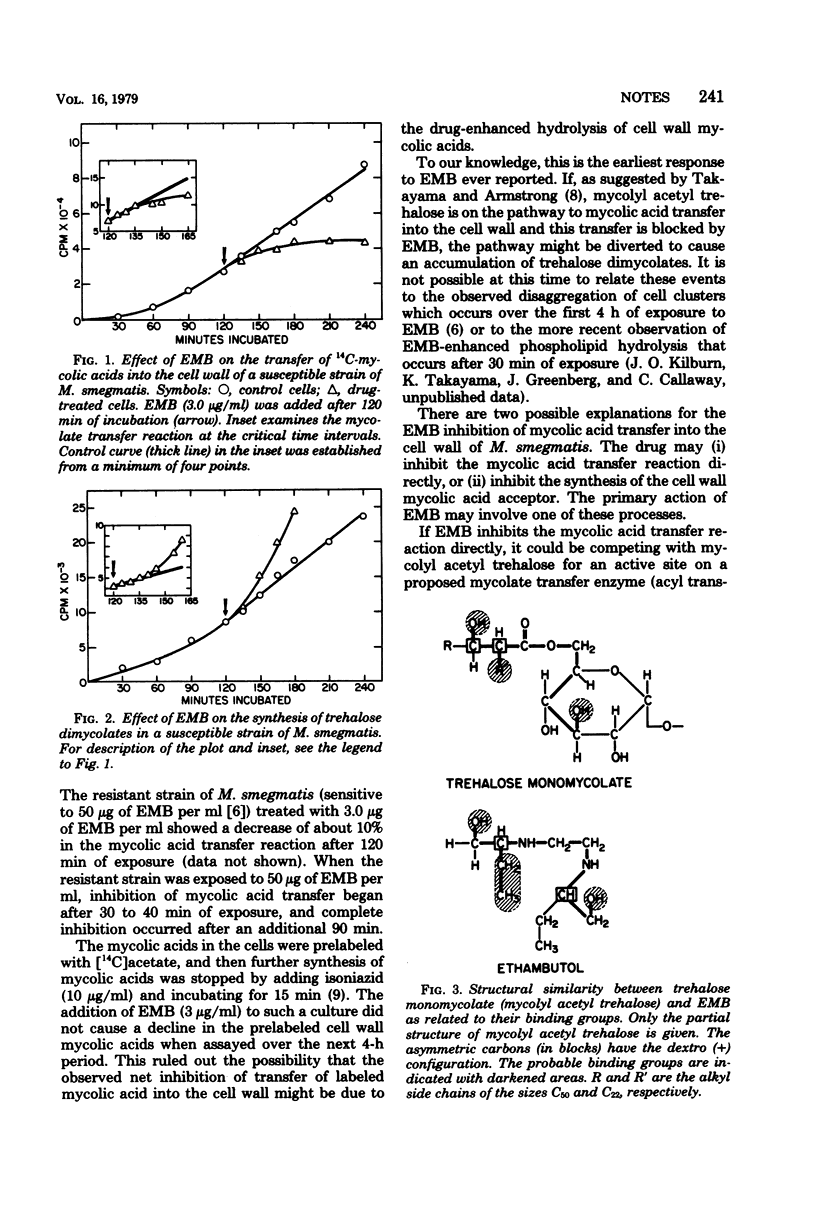Abstract
Ethambutol simultaneously inhibited the transfer (presumably via mycolyl acetyl trehalose) of mycolic acids into the cell wall and stimulated the synthesis of trehalose dimycolates of Mycobacterium smegmatis. Structural similarities of the drug and mycolyl acetyl trehalose suggested that competitive inhibition was involved.
Full text
PDF


Selected References
These references are in PubMed. This may not be the complete list of references from this article.
- Beggs W. H., Andrews F. A. Nonspecific ionic inhibition of ethambutol binding by Mycobacterium smegmatis. Antimicrob Agents Chemother. 1973 Aug;4(2):115–119. doi: 10.1128/aac.4.2.115. [DOI] [PMC free article] [PubMed] [Google Scholar]
- FORBES M., KUCK N. A., PEETS E. A. EFFECT OF ETHAMBUTOL ON NUCLEIC ACID METABOLISM IN MYCOBACTERIUM SMEGMATIS AND ITS REVERSAL BY POLYAMINES AND DIVALENT CATIONS. J Bacteriol. 1965 May;89:1299–1305. doi: 10.1128/jb.89.5.1299-1305.1965. [DOI] [PMC free article] [PubMed] [Google Scholar]
- Kanther R. Myambutol: chemistry, pharmacology, and toxicology. Antibiot Chemother. 1970;16:203–214. doi: 10.1159/000386822. [DOI] [PubMed] [Google Scholar]
- Kilburn J. O., Greenberg J. Effect of ethambutol on the viable cell count in Mycobacterium smegmatis. Antimicrob Agents Chemother. 1977 Mar;11(3):534–540. doi: 10.1128/aac.11.3.534. [DOI] [PMC free article] [PubMed] [Google Scholar]
- THOMAS J. P., BAUGHN C. O., WILKINSON R. G., SHEPHERD R. G. A new synthetic compound with antituberculous activity in mice: ethambutol (dextro-2,2'-(ethylenediimino)-di-l-butanol). Am Rev Respir Dis. 1961 Jun;83:891–893. doi: 10.1164/arrd.1961.83.6.891. [DOI] [PubMed] [Google Scholar]
- Takayama K., Armstrong E. L. Isolation, characterization, and function of 6-mycolyl-6'-acetyltrehalose in the H37Ra strain of Myocobacterium tuberculosis. Biochemistry. 1976 Jan 27;15(2):441–447. doi: 10.1021/bi00647a032. [DOI] [PubMed] [Google Scholar]
- Takayama K., Armstrong E. L. Metabolic role of free mycolic acids in Mycobacterium tuberculosis. J Bacteriol. 1977 Apr;130(1):569–570. doi: 10.1128/jb.130.1.569-570.1977. [DOI] [PMC free article] [PubMed] [Google Scholar]
- Takayama K., Wang L., David H. L. Effect of isoniazid on the in vivo mycolic acid synthesis, cell growth, and viability of Mycobacterium tuberculosis. Antimicrob Agents Chemother. 1972 Jul;2(1):29–35. doi: 10.1128/aac.2.1.29. [DOI] [PMC free article] [PubMed] [Google Scholar]
- Wilson T. M. Clinical experience with ethambutol. Antibiot Chemother. 1970;16:222–229. doi: 10.1159/000386824. [DOI] [PubMed] [Google Scholar]
- Winder F. G., Collins P. B., Whelan D. Effects of ethionamide and isoxyl on mycolic acid synthesis in Mycobacterium tuberculosis BCG. J Gen Microbiol. 1971 Jun;66(3):379–380. doi: 10.1099/00221287-66-3-379. [DOI] [PubMed] [Google Scholar]


